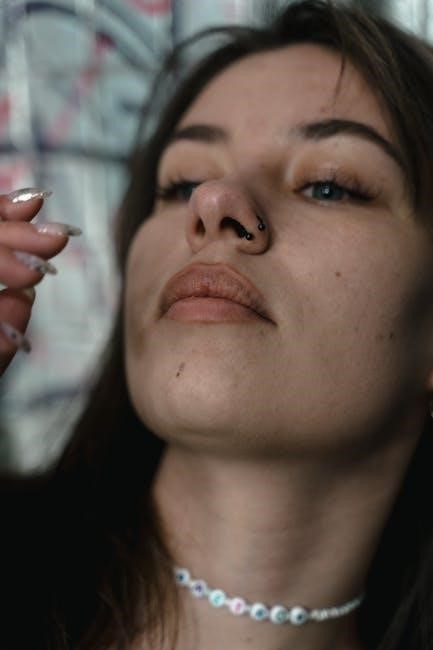
nostril piercing guide
Nostril piercings offer a delicate allure, blending personal style with cultural significance. This guide covers everything from types and jewelry to aftercare and health considerations, ensuring a seamless experience for newcomers.
1.1 What is a Nostril Piercing?
A nostril piercing involves creating a passage through the soft cartilage surrounding the nasal passages. It allows for the insertion of decorative jewelry, enhancing facial aesthetics. The piercing can be placed at various points on the nostril, including the dimple or higher up, depending on personal preference and nasal anatomy. This popular piercing is both subtle and versatile, making it a favorite for self-expression.
Types of Nostril Piercings
Nostril piercings come in varied styles, including standard and nasallang. The standard piercing is the most common, while the nasallang involves a dual passage through both nostrils and the septum.
2.1 Standard Nostril Piercing
A standard nostril piercing is a single-hole piercing through the nostril’s cartilage. It is the most common type, offering versatility in jewelry styles. Placed high or low, it suits various facial structures. Healing time typically ranges from 6 to 12 months. It is recommended to avoid tight rings during the initial healing phase and opt for studs or hoops post-healing for comfort and aesthetics.
2.2 Nasallang Piercing
The nasallang piercing is a unique, dual-hole piercing that enters one nostril, passes through the septum, and exits the other. It creates the illusion of two separate piercings but requires a single piece of jewelry. This style is visually striking but more complex, with a longer healing time and specific jewelry requirements. It is not suitable for everyone due to anatomical constraints but offers a bold aesthetic for those who can accommodate it.
Choosing the Right Jewelry
Selecting the right jewelry for a nostril piercing is crucial for comfort and style. High-quality materials like 14k gold, titanium, or stainless steel are recommended for safety and durability.
3.1 Recommended Materials
For nostril piercings, high-quality materials are essential to ensure safety and promote healing. 14k or 18k gold, titanium, and surgical stainless steel are top choices due to their biocompatibility. These materials minimize the risk of allergic reactions and support a smooth healing process. Avoid low-quality or plated metals, as they can cause irritation or infections. Opting for durable, non-reactive jewelry is key for long-term comfort and a successful piercing experience.
3.2 Jewelry Styles
Nostril piercings offer a variety of stylish jewelry options. Twist nose studs are popular for their comfort and security, while hoops and rings provide a bold look. Septum-style jewelry, such as clickers or hinged rings, is also a favorite. Each style complements the piercing differently, allowing individuals to choose based on personal preference and desired aesthetic. The right jewelry enhances the piercing’s appeal while ensuring comfort and ease of wear.
Piercing Placement and Anatomy
Piercing placement is crucial, influenced by nose anatomy. Symmetry and personal preferences guide where the jewelry sits, ensuring a balanced and aesthetically pleasing result for each individual.
4.1 Importance of Nose Anatomy
Nose anatomy plays a vital role in nostril piercings, as the shape and structure of the nostrils and septum influence placement and aesthetics. Understanding your nose’s unique features, such as nostril size and septum alignment, ensures a piercing that complements your face. Proper anatomy knowledge helps avoid complications and enhances the overall appearance, making it essential for a successful and visually appealing piercing experience.
4.2 Symmetry and Aesthetics
Symmetry is crucial for a visually appealing nostril piercing, as it enhances facial balance and overall attractiveness. The placement and angle of the piercing should complement the natural shape of the nose, ensuring a harmonious look. While personal style influences jewelry choice, maintaining symmetry ensures the piercing accentuates rather than distracts from the face. A well-executed, balanced piercing creates a polished, aesthetically pleasing result.

The Piercing Process
The process involves a professional using a needle to create a precise hole in the nostril. Guidance ensures accuracy and safety, with initial jewelry inserted post-procedure.
5.1 Preparation and Procedure
Preparation involves cleaning the area and marking the desired spot. A professional piercer uses a needle to create the hole, ensuring accuracy. The process is quick, with jewelry inserted immediately post-piercing. Proper hygiene and precision are crucial to minimize discomfort and risks, ensuring a smooth experience for the client.
5.2 What to Expect
During the procedure, you may feel a brief pinch, but it’s generally quick. Afterwards, mild swelling or redness is normal. Proper aftercare is essential to avoid complications. Keep the area clean, avoid tight jewelry, and be patient during healing. Expect some tenderness initially, but with good care, discomfort subsides. The process is straightforward, and many find it a manageable experience with the right preparation and professional guidance.

Healing Time and Aftercare
Nostril piercings typically heal within 6-9 months. Proper aftercare involves cleaning twice daily with a saline solution, avoiding harsh chemicals, and keeping the area dry to promote healing.
6.1 Healing Timeline
Nostril piercings typically heal within 6-9 months. Initial healing occurs in 2-3 weeks, with redness and swelling subsiding. Full healing takes longer as the tissue strengthens. Proper aftercare, like using saline solution and avoiding harsh chemicals, supports the process. Keeping the area clean and dry is crucial to prevent complications and ensure a smooth recovery.
6.2 Aftercare Tips
Proper aftercare is essential for healing. Clean the piercing twice daily with saline solution or mild soap. Avoid harsh chemicals and submerging in water. Gently pat dry after cleaning. Do not rotate the jewelry excessively. Keep tight clothing away to prevent irritation. Avoid touching the piercing unnecessarily. Maintain good hygiene and monitor for signs of infection, such as redness or swelling. Consistent care ensures a smooth recovery and prevents complications.
Health Risks and Complications
Infections, allergic reactions, and bleeding are common risks. Improper aftercare or using low-quality jewelry can lead to these issues. Severe cases may cause cartilage damage or septal perforation.
7.1 Common Risks
Nostril piercings can lead to infections if not cleaned properly. Allergic reactions to jewelry materials like nickel are also possible. Bleeding during or after the procedure is common, especially if the piercing is high up. Improper aftercare can result in swelling, redness, or discharge. In severe cases, cartilage damage or nasal septum issues may occur, emphasizing the importance of professional piercers and proper hygiene practices to minimize these risks effectively.
7.2 Prevention Tips
Preventing complications begins with proper hygiene. Clean the piercing twice daily with a saline solution and avoid harsh chemicals. Wash hands before touching the piercing to reduce infection risks. Use high-quality, nickel-free jewelry to minimize allergic reactions. Avoid tight or poorly fitted jewelry that may irritate the area. Keep the piercing dry and avoid submerging it in water until fully healed. These steps help reduce risks and support a smooth healing process.
Popularity and Workplace Acceptance
Nostril piercings are increasingly popular, often seen as a subtle yet stylish form of self-expression. Their growing acceptance in professional settings makes them a favored choice for many.
8.1 Growing Popularity
Nostril piercings have gained significant popularity in recent years, becoming a trendy form of self-expression. Their subtle yet stylish appeal makes them a favorite among individuals seeking a delicate facial piercing. Many view them as a first step into facial piercings due to their versatility and understated elegance. The rise of social media has further fueled their popularity, showcasing diverse styles and jewelry options that cater to various aesthetics and preferences.
8.2 Professional Settings
Nostril piercings are increasingly accepted in professional environments, though attitudes vary by industry. While some workplaces embrace body art, others may view piercings as less traditional. To navigate this, individuals often opt for discreet jewelry, such as small studs, to maintain a polished appearance. In conservative fields, removing the piercing or using retainers might be necessary. It’s wise to consider workplace policies before getting pierced to ensure compliance with dress codes or cultural expectations.
Cost of Nostril Piercing
Nostril piercings typically cost between $30 to $100, depending on the piercer and location. The price often includes the piercing and initial jewelry, varying by studio reputation.
9.1 Average Prices
The average cost of a nostril piercing ranges from $30 to $100, depending on the piercer’s expertise and the studio’s reputation. Basic piercings with simple jewelry typically fall on the lower end, while high-end materials or intricate designs may increase the price. Some studios charge separately for jewelry, while others include it in the initial fee. Prices vary by location and service quality.
9;2 Factors Affecting Cost
The cost of a nostril piercing varies based on factors like the piercer’s experience, studio reputation, and jewelry quality. High-end materials, such as 14k gold or platinum, increase the price. Location also plays a role, with urban areas typically charging more. Additionally, custom or intricate jewelry designs may inflate the cost. Some studios offer package deals, while others charge separately for piercing and jewelry, influencing the total expense.

Aftercare Products
Saline solution is essential for cleaning, while mild soap can be used for daily care. Avoid harsh chemicals to prevent irritation and promote healing.
10.1 Recommended Cleaning Solutions
Saline solution is the most recommended for cleaning nostril piercings, promoting healing without irritation. You can use pre-made saline solutions or make your own by dissolving 1/4 teaspoon of sea salt in 8 ounces of warm water. Mild, fragrance-free soap with warm water can also be used. Avoid harsh chemicals like hydrogen peroxide or alcohol, as they can delay healing. Always rinse with clean water after using soap to ensure the area remains clean and free from residue.
10.2 Avoiding Harsh Chemicals
Avoid using harsh chemicals like hydrogen peroxide, alcohol, or antibacterial soaps, as they can irritate the piercing and delay healing. These products can strip the skin of its natural oils, leading to dryness and potential complications. Stick to gentle, fragrance-free cleansers or saline solutions to maintain a clean and healthy environment for your nostril piercing to heal properly without unnecessary risks.
Maintenance and Jewelry Changes
Regular cleaning with saline solution prevents infections. Use high-quality materials like gold or titanium for jewelry. Avoid harsh chemicals and handle jewelry gently during cleaning.
11.1 When to Change Jewelry
Change jewelry after the piercing is fully healed, typically 6-12 months post-piercing. Avoid switching jewelry too early, as it can cause irritation or delay healing. Opt for high-quality materials like gold or titanium to minimize risks. Consult a professional piercer for guidance on safe jewelry changes and to ensure proper fit and comfort. This ensures the piercing remains healthy and visually appealing.
11.2 Tips for Jewelry Care
Proper jewelry care is essential for maintaining a healthy nostril piercing. Clean jewelry daily with mild soap and water, avoiding harsh chemicals. Store jewelry separately to prevent tangling or damage. Handle jewelry gently to avoid bending or warping. Regularly inspect for wear and tear, replacing as needed. For intricate designs, use a soft cloth to maintain shine. Always seek professional advice for complex jewelry maintenance to ensure longevity and safety.
Nostril piercings are a timeless and versatile way to express personal style. With proper care and attention, they can be a beautiful and meaningful addition to your appearance. Remember to prioritize hygiene, choose high-quality jewelry, and patience during the healing process. Whether subtle or statement-making, a well-maintained nostril piercing can enhance your confidence and reflect your unique identity. Embrace the journey responsibly and enjoy the aesthetic and cultural significance it brings to your life.